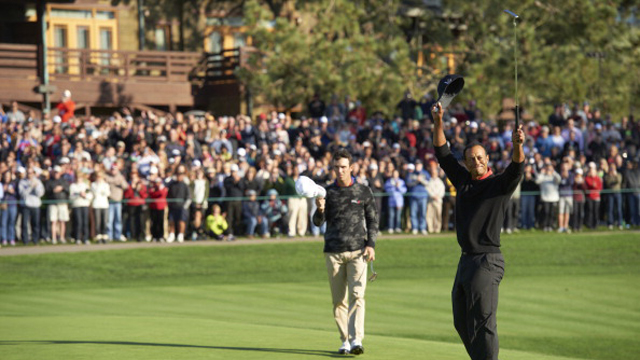NEWS
Eubanks: Of Course Tiger is Back

It’s a ridiculous question, but one that couldn’t be avoided in the early hours after the last putt fell at Torrey Pines.
Is Tiger back?
Well, the guy won three times last year and was a solid pick for Player of the Year before Rory McIlroy’s late-season surge and runaway win at the PGA Championship. He is also one of only two players with four victories in the last 11 months. The other one is McIlroy.
As if that were not enough, he had nine top-10 finishes last year, finished second on the money list and second in scoring average. So, yeah, Tiger is back.
But for some, that simply isn’t enough. Those who question Tiger’s resurgence point to the days when he dominated the game, periods like 2000 and 2001 when he completed the Tiger Slam and 2006 when he missed the cut at the U.S. Open after his father passed away and came back to win seven straight times, including two majors, before the end of the year.
Okay, he isn’t back to that point, but that was a once-in-a-lifetime period for our game. With the possible exceptions of Bob Jones, Byron Nelson and Ben Hogan, no one has overwhelmed golf the way Tiger did during those periods.
Others will point to the fairways he missed at Torrey Pines, the late double bogey, and the fact that he played the last five holes four over par on Monday as signs that he isn’t truly back. The old Tiger would have never let a lead slip like that, they will say.
The problem with that argument is he won the Farmers Insurance Open by four shots. If he’d let the lead slip away and had to hole a long putt in a playoff, maybe there would be a case. But people forget that Tiger has blown leads in the past. He bogeyed the last two holes of the 2005 Masters and was one improbable chip-in at 16 – “Oh. My. Goodness” – away from blowing a three-shot, 54-hole lead to Chris DiMarco. In that instance, he won in a playoff.
And in 2000, at the height of his dominance, he was one lucky bounce off a cart path away from losing the PGA Championship to Bob May.
Yes, Tiger won the 2000 U.S. Open by 15 shots and put on one of the most spectacular ball-striking displays in the game’s history at St. Andrews that same summer to win the British Open Championship. But people forget that he opened the Masters with scores of 75-72 and never contended.
Anyone looking for Tiger to come back as a svelte 25-year-old with a sprinter physique and the ability to will every important putt in the hole is going to be sorely disappointed. That Tiger is gone, just as the fat Jack Nicklaus of the early 60s gave way to the trim and fit golden boy of the 70s and the ageless wonder of 1980s.
Every great champion evolves. The skinny rookie Hank Aaron of 1954 looked and played nothing like the Hammerin' Hank of 1974, and the John Elway who led the Broncos to the 1986 Super Bowl was not the same quarterback to who won Super Bowl XXXIII in 1999.
Tiger isn’t the longest hitter anymore - there is no more talk of “Tiger-proofing” golf courses – and he rarely goes a round now without finding at least one bunker and a tree or two. Still, he continues to win, not as often and not as spectacularly as in years past, but the leaderboard doesn’t have room for style points.
There are other youngsters who are longer and stronger. McIlroy is clearly the best in the game at the moment, and guys whose names most casual fans have never heard before like Luke List hit the ball much farther than Tiger ever dreamed possible.
So, is Tiger back? Sure he is. He has been for awhile.
Is he the same? Of course not, just as no one out there is the same person they were a dozen years ago.
But as we creep ever closer to the beginning of major championship season, only the foolhardy would count Tiger out.
He might not be the man he once was, but with another win under his belt, he’s still, as they say, better than most.
